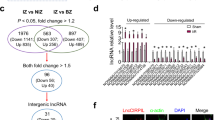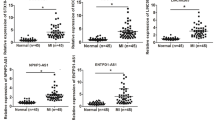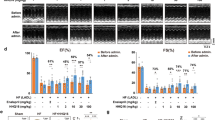Abstract
Myocardial ischemia-reperfusion (I/R) injury is a pathological process characterized by cardiomyocyte apoptosis, which leads to cardiac dysfunction. Increasing evidence shows that abnormal expression of long noncoding RNAs (lncRNAs) plays a crucial role in cardiovascular diseases. In this study we investigated the role of lncRNAs in myocardial I/R injury. Myocardial I/R injury was induced in mice by ligating left anterior descending coronary artery for 45 min followed by reperfusion for 24 h. We showed that lncRNA KnowTID_00006395, termed lncRNA-6395 was significantly upregulated in the infarct area of mouse hearts following I/R injury as well as in H2O2-treated neonatal mouse ventricular cardiomyocytes (NMVCs). Overexpression of lncRNA-6395 led to cell apoptosis and the expression change of apoptosis-related proteins in NMVCs, whereas knockdown of lncRNA-6395 attenuated H2O2-induced cell apoptosis. LncRNA-6395 knockout mice (lncRNA-6395+/−) displayed improved cardiac function, decreased plasma LDH activity and infarct size following I/R injury. We demonstrated that lncRNA-6395 directly bound to p53, and increased the abundance of p53 protein through inhibiting ubiquitination-mediated p53 degradation and thereby facilitated p53 translocation to the nucleus. More importantly, overexpression of p53 canceled the inhibitory effects of lncRNA-6395 knockdown on cardiomyocyte apoptosis, whereas knockdown of p53 counteracted the apoptotic effects of lncRNA-6395 in cardiomyocytes. Taken together, lncRNA-6395 as an endogenous pro-apoptotic factor, regulates cardiomyocyte apoptosis and myocardial I/R injury by inhibiting degradation and promoting sub-cellular translocation of p53.
Similar content being viewed by others
Log in or create a free account to read this content
Gain free access to this article, as well as selected content from this journal and more on nature.com
or
References
Li J, Xuan Z, Liu C. Long non-coding RNAs and complex human diseases. Int J Mol Sci. 2013;14:18790–808.
Huang H, Bu YZ, Zhang XY, Liu J, Zhu LY, Fang Y. LINC01433 promotes hepatocellular carcinoma progression via modulating the miR-1301/STAT3 axis. J Cell Physiol. 2019;234:6116–24.
Pan B, Zhao M, Xu L. Long noncoding RNA gastric cancer-associated transcript 3 plays oncogenic roles in glioma through sponging miR-3127-5p. J Cell Physiol. 2019;234:8825–33.
Zhang Y, Sun L, Xuan L, Pan Z, Hu X, Liu H, et al. Long non-coding RNA CCRR controls cardiac conduction via regulating intercellular coupling. Nat Commun. 2018;9:4176.
Wang YZ, Zhu DY, Xie XM, Ding M, Wang YL, Sun LL, et al. EA15, MIR22, LINC00472 as diagnostic markers for diabetic kidney disease. J Cell Physiol. 2019;234:8797–803.
Bian EB, Xiong ZG, Li J. New advances of lncRNAs in liver fibrosis, with specific focus on lncRNA-miRNA interactions. J Cell Physiol. 2019;234:2194–203.
Lan Y, Xiao XW, He ZC, Luo Y, Wu CF, Li L, et al. Long noncoding RNA OCC-1 suppresses cell growth through destabilizing HuR protein in colorectal cancer. Nucleic Acids Res. 2018;46:5809–21.
Li ZW, Hou PF, Fan DM, Dong MC, Ma MS, Li HY, et al. The degradation of EZH2 mediated by lncRNA ANCR attenuated the invasion and metastasis of breast cancer. Cell Death Differ. 2017;24:59–71.
Zhang Y, Jiao L, Sun LH, Li YR, Gao YQ, Xu CQ, et al. LncRNA ZFAS1 as a SERCA2a inhibitor to cause intracellular Ca2+ overload and contractile dysfunction in a mouse model of myocardial infarction. Circ Res. 2018;122:1354–68.
Hafner A, Bulyk ML, Jambhekar A, Lahav G. The multiple mechanisms that regulate p53 activity and cell fate. Nat Rev Mol Cell Biol. 2019;20:199–210.
Tripathi V, Shen Z, Chakraborty A, Giri S, Freier SM, Wu X, et al. Long noncoding RNA MALAT1 controls cell cycle progression by regulating the expression of oncogenic transcription factor B-MYB. PLoS Genet. 2013;9:e1003368.
Mahmoudi S, Henriksson S, Corcoran M, Mendez-Vidal C, Wiman KG, Farnebo M. Wrap53, a natural p53 antisense transcript required for p53 induction upon DNA damage. Mol Cell. 2009;33:462–71.
Sun F, Zhuang Y, Zhu H, Wu H, Li D, Zhan L, et al. LncRNA PCFL promotes cardiac fibrosis via miR-378/GRB2 pathway following myocardial infarction. Mol Cell Cardiol. 2019;133:188–98.
Li X, Luo S, Zhang J, Yuan Y, Jiang W, Zhu H, et al. lncRNA H19 alleviated myocardial I/RI via suppressing miR-877-3p/Bcl-2-mediated mitochondrial apoptosis. Mol Ther Nucleic Acids. 2019;17:297–309.
Wang ZH, Liu JL, Wu L, Yu Z, Yang HT. Concentration-dependent wrestling between detrimental and protective effects of H2O2 during myocardial ischemia/reperfusion. Cell Death Dis. 2014;5:e1297.
Li M, Ding W, Tariq MA, Chang W, Zhang X, Xu W, et al. A circular transcript of ncx1 gene mediates ischemic myocardial injury by targeting miR-133a-3p. Theranostics. 2018;8:5855–69.
Liu CY, Zhang YH, Li RB, Zhou LY, An T, Zhang RC, et al. LncRNA CAIF inhibits autophagy and attenuates myocardial infarction by blocking p53-mediated myocardin transcription. Nat Commun. 2018;9:29.
Wang K, Liu F, Liu CY, An T, Zhang J, Zhou LY, et al. The long noncoding RNA NRF regulates programmed necrosis and myocardial injury during ischemia and reperfusion by targeting miR-873. Cell Death Differ. 2016;23:1394–405.
Ma M, Hui J, Zhang QY, Zhu Y, He Y, Liu XJ. Long non-coding RNA nuclear-enriched abundant transcript 1 inhibition blunts myocardial ischemia reperfusion injury via autophagic flux arrest and apoptosis in streptozotocin-induced diabetic rats. Atherosclerosis. 2018;277:113–22.
Wu H, Zhu H, Zhuang Y, Zhang J, Ding X, Zhan L, et al. LncRNA ACART protects cardiomyocytes from apoptosis by activating PPAR-gamma/Bcl-2 pathway. J Cell Mol Med. 2020;24:737–46.
Song H, Conte JV Jr., Foster AH, McLaughlin JS, Wei C. Increased p53 protein expression in human failing myocardium. J Heart Lung Transplant. 1999;18:744–9.
Sajjad A, Novoyatleva T, Vergarajauregui S, Troidl C, Schermuly RT, Tucker HO, et al. Lysine methyltransferase Smyd2 suppresses p53-dependent cardiomyocyte apoptosis. Biochim Biophys Acta. 2014;1843:2556–62.
Naito AT, Okada S, Minamino T, Iwanaga K, Liu ML, Sumida T, et al. Promotion of CHIP-mediated p53 degradation protects the heart from ischemic injury. Circ Res. 2010;106:1692–702.
Jin X, Xu XE, Jiang YZ, Liu YR, Sun W, Guo YJ, et al. The endogenous retrovirus-derived long noncoding RNA TROJAN promotes triple-negative breast cancer progression via ZMYND8 degradation. Sci Adv. 2019;5:eaat9820.
Taniue K, Kurimoto A, Sugimasa H, Nasu E, Takeda Y, Iwasaki K, et al. Long noncoding RNA UPAT promotes colon tumorigenesis by inhibiting degradation of UHRF1. Proc Natl Acad Sci USA. 2016;113:1273–8.
Vousden KH, Vande Woude GF. The ins and outs of p53. Nat Cell Biol. 2000;2:E178–180.
Imamura K, Imamachi N, Akizuki G, Kumakura M, Kawaguchi A, Nagata K, et al. Long noncoding RNA NEAT1-dependent SFPQ relocation from promoter region to paraspeckle mediates IL-8 expression upon immune stimuli. Mol Cell. 2014;53:393–406.
Mao C, Wang X, Liu Y, Wang M, Yan B, Jiang Y, et al. A G3BP1-interacting lncRNA promotes ferroptosis and apoptosis in cancer via nuclear sequestration of p53. Cancer Res. 2018;78:3484–96.
Nag S, Qin J, Srivenugopal KS, Wang M, Zhang R. The MDM2-p53 pathway revisited. J Biomed Res. 2013;27:254–71.
Wang QS, Zhou J, Li X. LncRNA UCA1 protects cardiomyocytes against hypoxia/reoxygenation induced apoptosis through inhibiting miR-143/MDM2/p53 axis. Genomics. 2020;112:574–80.
Acknowledgements
The work was supported partly by the National Natural Science Foundation of China (No. 81872871, 82073844, 82070283), Postdoctoral Science Foundation of China (2021T140172) and National Science and Technology Major Project (2018ZX10101003-003-003).
Author information
Authors and Affiliations
Contributions
MYZ, YJL, ZWP, and CQX designed and supervised this study; LFZ, QZ, LZ, XD, and XWZ performed the cell experiments; XYP, LLP, BM, and WDS performed the animal experiments; LFZ, Q,Z and LZ performed the statistical analysis; YJL, MYZ, LFZ and QZ wrote the manuscript; All authors contributed to manuscript revision, and read and approved the submitted version.
Corresponding authors
Ethics declarations
Competing interests
The authors declare no competing interests.
Supplementary information
Rights and permissions
About this article
Cite this article
Zhan, Lf., Zhang, Q., Zhao, L. et al. LncRNA-6395 promotes myocardial ischemia-reperfusion injury in mice through increasing p53 pathway. Acta Pharmacol Sin 43, 1383–1394 (2022). https://doi.org/10.1038/s41401-021-00767-5
Received:
Accepted:
Published:
Issue date:
DOI: https://doi.org/10.1038/s41401-021-00767-5
Keywords
This article is cited by
-
The Role of P53 in Myocardial Ischemia-Reperfusion Injury
Cardiovascular Drugs and Therapy (2025)
-
METTL3, m6A modification, and EGR1: interplay affecting myocardial I/R injury outcomes
Cell Biology and Toxicology (2024)
-
Long Noncoding RNAs Involved in Cardiomyocyte Apoptosis Triggered by Different Stressors
Journal of Cardiovascular Translational Research (2022)



